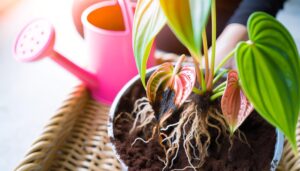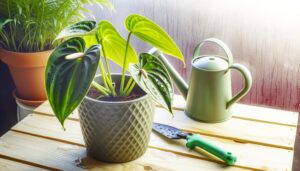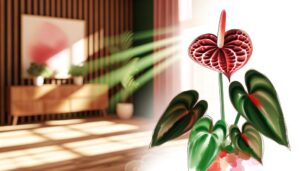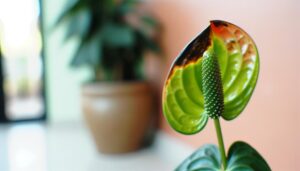What Does It Mean When Anthurium Leaves Turn Brown and How to Fix It
Brown leaves on your anthurium often mean improper watering, insufficient humidity, or too much direct sunlight. Overwatering causes root rot, while underwatering results in dry, crispy edges.
Keep the soil consistently moist and let the top inch dry out before you water. Anthuriums thrive in humidity levels above 60%; use a humidifier or pebble tray to boost moisture.
Direct sunlight can scorch leaves, so provide bright, indirect light. Pests like spider mites and nutrient deficiencies can also cause browning.
Inspect regularly for pests and use balanced fertilizer. For more detailed solutions, there's a wealth of information available for your anthurium's care.
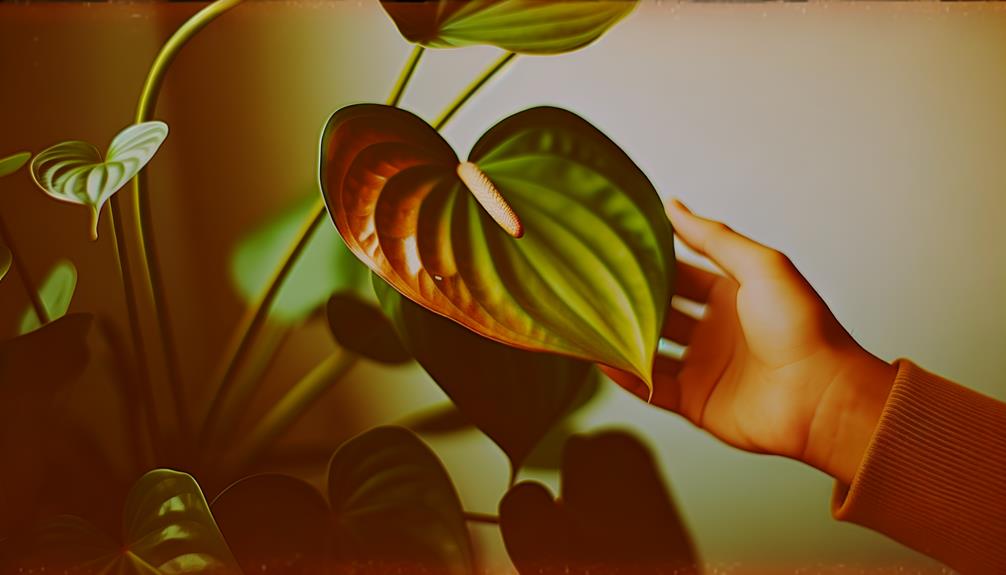
Key Takeaways
- Brown leaves can result from improper watering; ensure soil is consistently moist but well-draining.
- Insufficient humidity causes leaf browning; maintain at least 60% humidity with humidifiers or pebble trays.
- Direct sunlight can scorch leaves; provide bright, indirect light for optimal growth.
- Pests like spider mites and aphids can cause browning; inspect and treat with insecticidal soap or neem oil.
- Nutrient deficiencies lead to browning; use balanced fertilizer and monitor soil pH and nutrient levels.
Causes of Brown Leaves
When your anthurium leaves start turning brown, it's usually due to environmental stressors like improper watering, insufficient humidity, or inadequate light. To identify the root cause, first, check your plant's location. Anthuriums thrive in bright, indirect light; direct sunlight can scorch the leaves.
Next, assess the humidity levels. These tropical plants need at least 60% humidity to stay healthy. If your indoor environment is dry, consider using a humidifier or placing the plant on a pebble tray filled with water.
Lastly, examine your watering habits. Although watering will be discussed later, note that both overwatering and underwatering can lead to brown leaves. Understanding these factors helps you maintain an ideal environment for your anthurium.
Watering Issues
Often, improper watering is a primary cause of anthurium leaves turning brown, so understanding the specific needs of your plant is crucial. Overwatering can lead to root rot, which deprives roots of oxygen, causing brown, mushy leaves. On the other hand, underwatering stresses the plant, leading to dry, crispy leaf edges.
Aim for consistently moist but well-draining soil. Water your anthurium when the top inch of soil feels dry. Use room-temperature water to avoid shocking the roots. It's important that the pot has drainage holes to prevent water from stagnating. Regularly check the soil moisture level and adjust your watering schedule accordingly.
Humidity Levels
Maintaining high humidity levels is essential for preventing anthurium leaves from turning brown, as these tropical plants thrive in environments with 70-80% humidity.
To achieve this, you can use a few practical methods:
- Humidifiers: Place a humidifier near your anthurium to maintain the ideal moisture levels.
- Pebble Trays: Fill a tray with water and pebbles, then set your plant pot on top. As the water evaporates, it increases humidity around the plant.
- Grouping Plants: Position your anthurium close to other plants to create a micro-humid environment.
- Misting: Lightly mist your anthurium with water using a spray bottle, but avoid overdoing it to prevent fungal issues.
Pest Problems
Pest infestations, particularly from spider mites, aphids, and mealybugs, can lead to anthurium leaves turning brown by sucking the sap and causing tissue damage. You should closely inspect your plant for these pests, often found on the undersides of leaves or near new growth.
Spider mites leave fine webbing, aphids create sticky residue, and mealybugs appear as cottony masses. To combat these pests, use insecticidal soap or neem oil, ensuring thorough coverage of all plant parts. Regularly wipe leaves with a damp cloth to remove pests and their residues.
Additionally, maintain proper humidity and airflow to create an environment less conducive to infestations. Consistent monitoring and prompt action are key to keeping your anthurium healthy.
Nutrient Deficiencies
Nutrient deficiencies can greatly impact your Anthurium's health, causing leaf browning. An imbalance of essential nutrients like nitrogen, phosphorus, and potassium, or a lack of crucial micronutrients such as iron and magnesium, disrupts the plant's growth and vigor.
To prevent these issues, monitor soil quality and consider using a balanced fertilizer.
Essential Nutrient Imbalance
An imbalance in essential nutrients can cause anthurium leaves to turn brown, often indicating deficiencies in key elements like nitrogen, potassium, or magnesium. When your plant lacks these nutrients, it struggles to perform crucial functions, leading to brown, withered leaves.
To identify and correct this, you should:
- Test the soil: Check the pH and nutrient levels using a soil test kit.
- Fertilize appropriately: Use a balanced fertilizer formulated for anthuriums.
- Monitor plant health: Watch for continued signs of discoloration or improvement.
- Adjust watering practices: Over- or under-watering can exacerbate nutrient issues.
Lack of Micronutrients
Beyond the major nutrients, your anthurium also requires a variety of micronutrients like iron, zinc, and manganese to maintain its vibrant, healthy foliage. When these elements are deficient, you might notice brown spots or edges on the leaves.
Iron deficiency, for example, can cause yellowing between the veins, leading to browning if unaddressed. To fix this, use a balanced, water-soluble fertilizer that includes micronutrients. Ensure your soil pH is in the optimum range (5.5 to 6.5) because pH levels affect micronutrient availability.
Additionally, consider using chelated forms of these nutrients for better absorption. Regularly monitor your plant's health and adjust your care routine as needed to keep your anthurium thriving.
Light Conditions
When your anthurium leaves start turning brown, consider the light conditions in which the plant is placed. Insufficient light exposure can cause the leaves to lose their vibrant color and brown at the edges, while excessive direct sunlight can scorch the leaves, leading to the same issue.
Aim for bright, indirect light to maintain healthy foliage.
Insufficient Light Exposure
Lack of adequate light exposure can cause Anthurium leaves to turn brown due to the plant's inability to photosynthesize efficiently. When your Anthurium doesn't get enough light, it struggles to produce the energy it needs, leading to discoloration and poor overall health.
Here are some signs your Anthurium isn't getting enough light:
- Slow growth: Your plant seems to be stuck in a growth rut.
- Leggy appearance: Stems grow longer and thinner, reaching for light.
- Pale leaves: Leaves lose their vibrant green color.
- Leaf drop: Leaves may fall off prematurely.
To fix this, place your Anthurium near a bright, indirect light source. Consider using artificial grow lights if natural light is insufficient. Your plant will thank you with lush, green foliage.
Excessive Direct Sunlight
Exposing your Anthurium to excessive direct sunlight can scorch its leaves, causing them to turn brown and deteriorate. Anthuriums thrive in bright, indirect light, mimicking their native tropical understory environment.
When placed in direct sunlight, the intense rays can damage the plant's cellular structure, leading to leaf burn. You should position your Anthurium where it receives filtered light, such as near a north or east-facing window. If direct sunlight is unavoidable, diffuse it with sheer curtains or blinds.
Regularly rotate the plant to ensure even light distribution, preventing one side from becoming overly exposed. By adjusting its light exposure, you'll help maintain healthy, vibrant leaves and prevent the unsightly browning caused by sun damage.
Effective Treatment Steps
To effectively treat browning Anthurium leaves, start by identifying and addressing any underlying issues such as improper watering, inadequate humidity, or pest infestations.
First, check the soil moisture; Anthuriums prefer consistently damp but not waterlogged soil.
Next, boost humidity by misting the plant or using a humidifier.
Inspect your plant for pests like spider mites or aphids, and treat them with insecticidal soap if needed.
Lastly, make sure it's not exposed to excessive direct sunlight.
- Consistently damp soil: Over-watering or under-watering can stress the plant.
- Increased humidity: Use a humidifier or mist the leaves.
- Pest control: Regularly check and treat for insects.
- Proper light conditions: Avoid direct, harsh sunlight.
Implement these steps, and your Anthurium should thrive.
Conclusion
Imagine your Anthurium as a delicate balance of elements, like a finely tuned orchestra. When the leaves turn brown, it's a sign that one instrument is out of tune—be it water, humidity, pests, nutrients, or light.
To restore harmony, adjust each element with precision: water wisely, boost humidity, manage pests, maintain balanced nutrition, and provide proper light.
By doing so, you'll conduct a symphony of vibrant, healthy leaves, turning your plant into a masterpiece.


